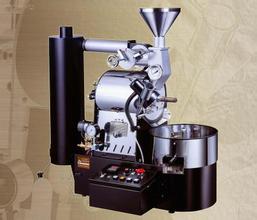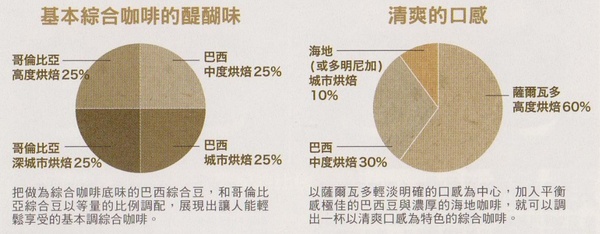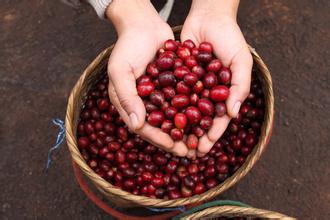Types and characteristics of roaster introduction of hot-air direct-fire semi-hot-air coffee roaster
There are three common types of roaster, namely, hot air type, direct fire type, and semi-direct fire semi-hot air type. Next, I would like to introduce to you the characteristics of the three models.
1. Hot air type:
The hot air roaster uses the blower to suck in the air, raises the temperature of the air through a heating coil, and uses hot air as the heating source to bake coffee beans. hot air can not only provide the temperature needed for baking. you can also use the power of airflow to stir coffee beans and kill two birds with one stone. Now there is a professional hot air roaster on the market, which combines the electric tumbling baking chamber with heat flow to make the coffee beans heated more evenly.
Advantages: high thermal efficiency, fast heating, relatively uniform heating of raw beans, easy to control.
Disadvantages: because the heating efficiency is high, it is easy to lead to excessive heating, resulting in the bean raw "core" is the so-called entrainment, and the temperature rise is too high, it is easy to make the coffee caramelization reaction is not enough!
The characteristics of the taste: the acidity is obvious, the taste is relatively clean and simple, but the taste is not rich enough and lacks depth, and deep baking is easy to produce pungent smell!

two。 Direct fire:
As the name implies, direct fire is the use of flame to directly heat coffee beans. Up to now, direct fire includes infrared ray and electric heating pipe in addition to general flame (including gas stove fire and charcoal fire).
Advantages: the baking time is long, which makes the caramelization reaction more sufficient and the flavor more rich.
Disadvantages: it is easy to cause uneven baking, and if the heat is not well controlled, it is also easy to scorch coffee beans and form a scorched bitter taste.
Taste characteristics: sweet, bitter and sour flavor is deeper than hot air, mellow, smooth taste, but the dry aroma of coffee beans is weak, sometimes when the roast is light, the taste of coffee beans will produce a strong smell of grass!
3. Semi-direct fire and semi-hot air:
The baking method which combines the advantages of direct fire type and hot air type is the mainstream of commercial coffee machine at present. Semi-direct-fire semi-hot air baking is actually similar to direct-fire baking, but because there are no holes in the outer wall of the baking container, the flame will not directly touch the coffee beans. In addition, ventilation and exhaust equipment should be added to introduce the hot air outside the baking container into the baking room to improve baking efficiency. Another function of this ventilation equipment is to suck out the silver skin of coffee beans. Avoid burning in the baking room due to high temperature to affect the taste of coffee beans.
This kind of roaster has the advantages and disadvantages of both hot air type and direct fire type, and its heating mode is changed by adjusting the speed of hot air and baking chamber. The bigger the hot air is, the faster the speed is, the closer it is to the hot air type, on the contrary, it is close to the direct fire type.
Taste characteristics: the overall coffee beans are rich in taste, high mellow, distant from dry and wet aromas, and excellent for the characteristics of coffee producing areas.
Source: happy Coffee Xiao Xu's blog
Important Notice :
前街咖啡 FrontStreet Coffee has moved to new addredd:
FrontStreet Coffee Address: 315,Donghua East Road,GuangZhou
Tel:020 38364473
- Prev

Blending of single mixed coffee espresso blending proportion and flavor characteristics of coffee beans
The previous has briefly talked about the meaning of the blending of comprehensive coffee and two more popular blending concepts. Today, I would like to share with you several specific recipes for mixed coffee (as each family has its own understanding of different roasting and the quality of the raw beans used, the formula mentioned in this article may not be suitable for everyone. The numbers represent the recommended ratio). Comprehensive coffee
- Next

Distinguish coffee beans and the grading of coffee beans how to distinguish the quality of coffee beans coffee knowledge
● distinguishes the key names and specifications of coffee beans the name of the port of export of ● can tell the shipping route from the name of the port of exit marked. Coffee from the same origin or the same brand has a certain route, so it is also exported from the same port. For example, if it is marked "Brazil." "Santos" means that this is coffee exported from Santos, with the exception of those marked "mocha".
Related
- Beginners will see the "Coffee pull flower" guide!
- What is the difference between ice blog purified milk and ordinary milk coffee?
- Why is the Philippines the largest producer of crops in Liberia?
- For coffee extraction, should the fine powder be retained?
- How does extracted espresso fill pressed powder? How much strength does it take to press the powder?
- How to make jasmine cold extract coffee? Is the jasmine + latte good?
- Will this little toy really make the coffee taste better? How does Lily Drip affect coffee extraction?
- Will the action of slapping the filter cup also affect coffee extraction?
- What's the difference between powder-to-water ratio and powder-to-liquid ratio?
- What is the Ethiopian local species? What does it have to do with Heirloom native species?

